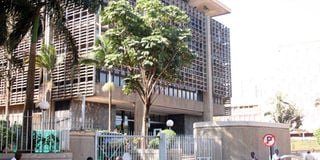June CBR expected to stay at 11.5%

The Bank of Uganda premises in Kampala. The bank is expected to maintain its Central Bank Rate due to prevailing market conditions. FILE PHOTO
What you need to know:
Analysts predict the rate to remain unchanged because of the relatively stable inflation
Kampala
Commercial banks will borrow from the Central Bank at the current lending rate if analysts’ expectations for the benchmark lending rate to stay unchanged come true.
Bank of Uganda (BoU) is expected to announce the June Central Bank Rate (CBR) – the rate at which BoU lends to commercial banks for onward lending to their clients, today (Wednesday) and analysts expect the rate to remain unchanged at 11.5 per cent due to the prevailing market conditions.
Mr Stephen Kaboyo, the Alpha Capital Partners managing director, told the Daily Monitor on Monday that despite the 1.3 percentage point decrease in May, there is little reason for BoU to change policy, ahead of the budget statement for 2014/2015, where the impact of new economic policies on the markets has not yet been assessed going forward.
Maintaining the CBR
“Forecasts continue to indicate slow but steady growth and inflation close to its target. I believe therefore that BoU will stand put,” Mr Kaboyo said.
“The current economic variables present a case of mixed balance of risks surrounding the inflation, exchange rate that has lately been depreciating and the growth outlook,” he added.
Bank of Uganda has held the CBR at 11.5 per cent for six consecutive months since December last year.
The Consumer Price Index – the official measure of inflation – eased from 6.7 per cent in April to 5.4 per cent in May due to a decrease in food prices and increased production and supply to markets, according to the Uganda Bureau of Statistics.
Although the CBR has declined over the months to stimulate aggregate demand and economic recovery, commercial bank lending rates are still high, averaging at about 20 per cent.
Ms Razia Khan, Standard Chartered Bank Africa regional head of research, also echoed similar views, saying that with a 1.3 percentage decrease in inflation, there is limited room for easing and no immediate pressure for tightening the CBR.
The monetary policy stance is one of the tools BoU uses to control inflation by reducing growth in bank credit and slowing down demand for goods and services.
The measure worked well to bring down inflation from 30.4 per cent in October 2011, to 3.4 per cent in April this year before peaking up again to the current 5.4 per cent.
The CBR sets a benchmark for other interest rates in the economy. Normally, commercial banks will set the interest rates that they charge on their loan rates above the CBR, because these lending rates must also cover the cost of mobilising funds, administering the loans and of possible losses from loan defaults.
CURBING INFLATION WITH CENTRAL BANK RATE
To curb inflation, the Bank of Uganda raises its policy interest rate – the CBR. The Bank of Uganda does not directly control the interest rates which commercial banks charge their borrowers or offer to depositors. These interest rates depend on the specific characteristics of individual customers.
In a market economy, commercial banks must have some freedom to set interest rates in accordance with market conditions and business costs if the financial sector is to develop and serve the needs of its customers. High lending rates are often necessary to allow banks to extend credit to risky projects.




